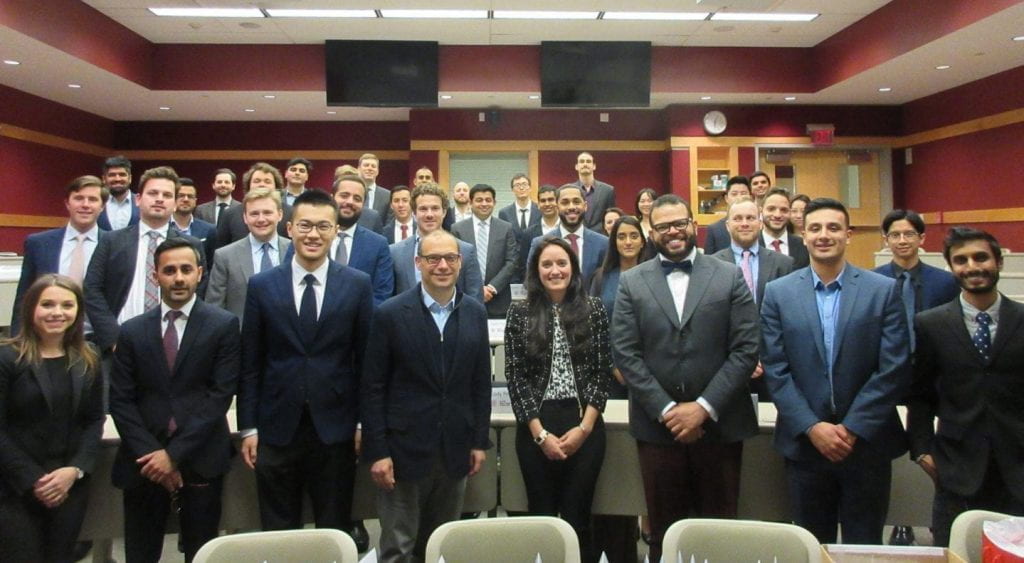
On Thursday, February 27th, 2020, the Cornell Baker Program in Real Estate hosted Douglas Eisenberg (AAP ‘95), founding principal of A&E Real Estate, a property management and investment firm with multifamily properties throughout New York City. Mr. Eisenberg was accompanied by Maggie McCormick (B.S. ‘09), the firm’s President.
Mr. Eisenberg’s love for New York showed as he discussed the vibrant, lively nature of the ever-growing city. While A&E has a current portfolio of approximately 15,000 rental properties in four boroughs—Queens, Brooklyn, Manhattan and The Bronx, the firm still has room to grow given the almost 2.6 million apartment units spread across New York City. Therefore, in spite of the opportunity to invest in property in markets such as Los Angeles and Miami, Mr. Eisenberg has stayed focused on New York City.
With the intention to offer quality residences in select neighborhoods, Mr. Eisenberg founded A&E Real Estate by acquiring the best properties in the best locations. Over the years, the firm has grown to about 500 employees with offices in New York City. As one of the largest landlords in New York City, Mr. Eisenberg pays close attention to the specific needs of his residents, who he describes as the “backbone of New York City.” A&E’s primary goal is “to provide best in-class service to its residents.” Mr. Eisenberg explained that the New York City market is incredibly segmented and owned primarily by local families who, as he explained in one anecdote, hold and manage large portfolios from ground floor apartments in the boroughs.
A&E’s strategy for growth is a slow and steady one, wherein it acquires under-maintained properties that show potential for value-addition through capital improvements and more efficient management. While Mr. Eisenberg would hold properties forever, Ms. McCormick is the one to encourage a timely sale to harvest gains within their 7-10 year hold period. According to her, it is important to distinguish between the value-add period (capital improvements) and the long-term hold period (value creation). Major functions at A&E are owned and managed in-house, allowing it to have a tight hold over expenses, quality and timing. The firm’s primary divisions include business development, legal, construction, property management, asset management, acquisition, finance and accounting, while office operations are divided into administrative and information technology.
Elaborating further on the firm’s acquisition strategy, Ms. McCormick explained that they prefer to purchase off-market buildings with bare-bone information, instead of fully marketed deals. A&E selects the best neighborhoods (e.g. Sunnyside, Forest Hills, Jamaica, and Regal Park, to name just a few in Queens) and builds diverse portfolios that provide a lot of optionality in terms of selling to a number of buyer profiles. The acquisition team, Ms. McCormick explained, should have deep sector understanding of these neighborhoods and micro-neighborhoods so that decisions can be made in an informed manner.
As ever more stringent rent regulations make matters harder for property owners and managers in New York, outsiders fail to successfully enter the market while insiders start looking at other markets. A&E briefly explored other markets in the United States, but soon realized that the fundamentals of New York City fundamentals were strong, despite the new regulations. Furthermore, demand for rentals increased significantly, while new supply dwindled. Ms. McCormick therefore made the decision to better understand the new regulations and continue to acquire real estate in strong locations. With the pre-regulation opportunistic investors out of the market by June 2019, A&E could focus on its slow and steady return profile and enjoy the benefits of long-term capital appreciation.
Ms. McCormick described two of A&E’s portfolios, one of which includes 10 buildings across the Bronx, Queens, Yonkers, Midtown, and Upper East Side. At sale, the Yonkers building was 30% vacant and in need of a heavy lease-up. To explain how this deal came together for A&E, Ms. McCormick recalled the eighteen month negotiation A&E endured with feuding family members entangled in litigation right up until the contract signing date.
Buying family-owned property in New York City requires a tremendous amount of due diligence. Even with rent stabilization maintaining constant loss to lease, market cap rates can be as low as 3%. These cap rates favor slow and steady return profiles over more aggressive strategies. Playing the long game is the way to go in such a climate, according to Mr. Eisenberg. Therefore, A&E has invested significant capital into improving the value of its buildings even when original owners would not or could not put in any capital.
The second portfolio was purchased between 2012 and 2015, and includes buildings in Upper Manhattan and Queens. The main strategy here was consistent with the general approach of A&E, but there were also additional benefits due to the recent expansion of Columbia Presbyterian in the northern Manhattan area. As Columbia Presbyterian took over significant amounts of real estate in this area, new jobs were being created rapidly, thus creating a need for housing in and around Washington Heights. This presented a massive opportunity for A&E.
As parting advice, Mr. Eisenberg reminded the Baker students that it is important to spending time away from screens and in the field. He encouraged them to take risks and go outside their comfort zones. The Baker Program thanks Mr. Eisenberg and Ms. McCormick for their visit and wishes them continued success in the future.
